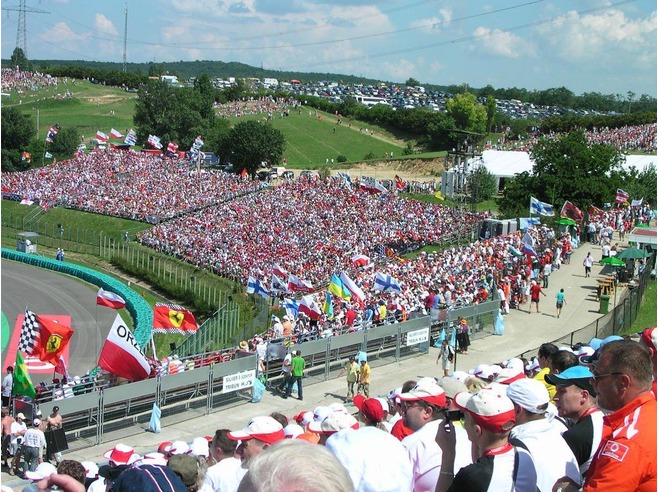The history of the Hungarian Grand Prix actually began in Monte Carlo, at the 1983 Monaco Grand Prix. During the weekend, Bernie Ecclestone, the man who runs Formula One, told a friend that his family was of Hungarian origin, and that he would like to see a World Championship race behind the then "iron curtain" imposed by Eastern Europe after World War II. The suggestion was taken to the minister of international relations, who started the project of having Formula One back in the country after almost five decades without any major motor racing events.

The history of the Hungarian Grand Prix actually began in Monte Carlo, at the 1983 Monaco Grand Prix. During the weekend, Bernie Ecclestone, the man who runs Formula One, told a friend that his family was of Hungarian origin, and that he would like to see a World Championship race behind the then "iron curtain" imposed by Eastern Europe after World War II. The suggestion was taken to the minister of international relations, who started the project of having Formula One back in the country after almost five decades without major motor racing events.
It took two and a half years of negotiations until the contract was signed - in September 1985 - for Hungary to have its own Grand Prix for five years. In eight months, the circuit was ready in one of the most beautiful cities of the Formula 1 calendar: Budapest. And the top motor racing category landed in Hungaroring for its first GP, which took place on August 10, 1986. Bernie Ecclestone's idea, insane at first, had come true. And Formula One was entering a socialist country, which never left the calendar, and has a contract to host the category at least until 2026.
Brazil has an excellent record in the race. Nelson Piquet, with Williams, won the first two editions, in 1986 and 1987. Ayrton Senna, with McLaren, won three: 1988, 1991, and 1992. Rubens Barrichello, with Ferrari, won in 2002. The biggest winner is the Englishman Lewis Hamilton, with eight wins. Spaniard Fernando Alonso, in 2003, won in Hungaroring for the first time in the category.
Learn a little more about Hungary
The Republic of Hungary is a country in Central Europe. In terms of borders, it has Slovakia to the north, Ukraine to the northeast, Romania to the east, Austria to the west, and Serbia, Croatia and Slovenia to the south. The territory is basically flat, being more mountainous in the north. The largest river is the Danube, which practically divides the Hungarian Great Plain and the so-called mountainous area. It also has the largest freshwater lake in Europe, Lake Balaton.
The population basically consists of people from Hungary itself, 98% of the total. There are also minority groups: Roma, Germans, Slovaks, Croats, Serbs, and Romanians. The main cities are the capital Budapest (1,930,000 inhabitants), Debrecen (210,000), and Misklolc (182,000).
The total population is 10.06 million. The national date is August 20, Constitution Day. The population density is 109 inhabitants/km2, and the predominant climate is temperate continental. The official language is Hungarian, but German, Slovak, Ukrainian, Slovene, Serbian, Croatian, and Hebrew are also spoken. The most widespread religion is Christianity.
The political regime is parliamentary, and the main power body is the government, headed by the Prime Minister, who must appoint the other ministers, who must also be approved by parliament. The National Assembly (Orszaggyulés) exercises legislative power, and deputies are elected in a mixed manner, by proportional and majority vote. The term of office is four years. The President of the Republic, elected every five years, is the head of state, is representative, proposes laws, and can hold referendums.
Hungary is a good example of a successful transition from a socialist to a market economy, with the private sector providing 80% of the GDP. Most of its exports go to European countries, with industrial tools, transport equipment, chemicals, vehicle engines, electrical machinery, and textiles being the most widespread items.
The Hungaroring Circuit
The Hungaroring circuit was inaugurated on March 24, 1986, with the Drapal Memorial Race. The Hungaroring has 14 curves, a twisting track, and is considered difficult to overtake, second only to Monaco in the current Formula 1 calendar. The grip conditions on the asphalt are quite modest, and the wheels often lock under braking. The Hungarian track is characterized by many low-speed corners, and ventilation of the brake discs is vital to avoid problems during the race, as well as possible pit stops.
The first Formula 1 race at the Hungaroring was held on August 10, 1986. Nelson Piquet, who drove a Williams, won. The following year (1987), victory was again the Brazilian's. Nelson Piquet's victory in the 1986 Formula 1 Hungarian Grand Prix was also marked by one of the most beautiful overtaking races in the history of the category. The dispute between Piquet and Ayrton Senna started right at the start and lasted almost the entire race. Senna took the lead, Piquet passed, but soon after he had to stop in the pits. Williams took a while to change tires and Piquet ended up coming back behind Senna. The first overtaking attempt was unsuccessful, Senna closed the gap and Piquet had to back off. Two laps later, Piquet made another attempt, which became one of the most spectacular maneuvers in history. Piquet threatened to go in from the inside, and to defend himself, Senna threw the car to the right and stood in the middle of the track. Piquet then pulled the car to the outside and left to brake as late as possible, completing the overtake in the last meter of track, skidding on all four wheels and leaving no room for his rival to react. The maneuver was commented on by the renowned Jackie Stewart: "It was like doing a looping in a Boeing 747. The most beautiful maneuver I have ever seen in Formula One.
www.autoracing.com.br